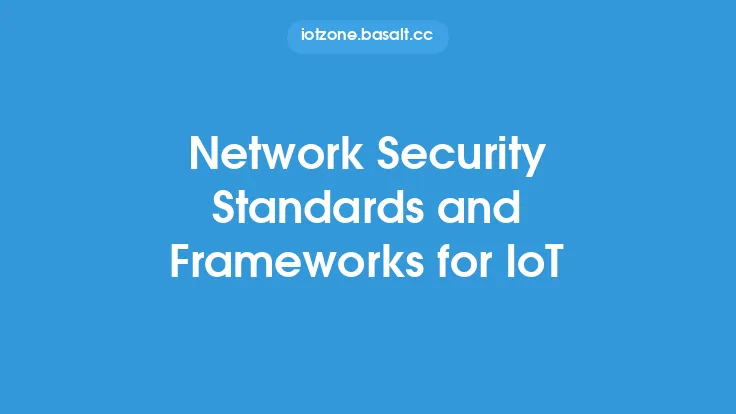The increasing number of IoT devices connected to the internet has created a vast attack surface, making network security a critical concern. IoT devices, such as smart home appliances, industrial control systems, and wearable devices, are vulnerable to various types of cyber threats, including hacking, malware, and denial-of-service (DoS) attacks. These threats can compromise the confidentiality, integrity, and availability of data, as well as disrupt the normal functioning of devices and systems.
Introduction to IoT Network Security Challenges
IoT devices often have limited computational resources, memory, and power, making it challenging to implement robust security measures. Additionally, many IoT devices are designed with convenience and functionality in mind, rather than security, which can lead to vulnerabilities in the device's firmware, software, and communication protocols. The diversity of IoT devices and protocols also creates complexity in securing IoT networks, as different devices and protocols may require different security approaches. Furthermore, the lack of standardization in IoT security makes it difficult to develop and implement effective security solutions.
Security Threats to IoT Devices
IoT devices are susceptible to various types of security threats, including device hacking, malware, and DoS attacks. Device hacking involves exploiting vulnerabilities in the device's firmware or software to gain unauthorized access or control. Malware, such as viruses, worms, and trojans, can be used to compromise the device's functionality or steal sensitive data. DoS attacks, which involve flooding the device with traffic in order to overwhelm its resources, can disrupt the device's normal functioning and make it unavailable for legitimate use. Other security threats to IoT devices include eavesdropping, man-in-the-middle (MitM) attacks, and physical attacks, such as device tampering or theft.
Secure Communication Protocols for IoT Devices
Secure communication protocols are essential for protecting data transmitted between IoT devices and the cloud or other devices. Common secure communication protocols used in IoT include Transport Layer Security (TLS), Datagram Transport Layer Security (DTLS), and Secure Sockets Layer (SSL). These protocols provide end-to-end encryption, authentication, and integrity checking, ensuring that data is protected from eavesdropping, tampering, and replay attacks. Additionally, protocols such as CoAP (Constrained Application Protocol) and MQTT (Message Queuing Telemetry Transport) provide secure communication for constrained devices and networks.
Device Authentication and Authorization
Device authentication and authorization are critical components of IoT network security. Device authentication involves verifying the identity of devices before allowing them to connect to the network or access resources. Device authorization involves controlling what actions devices can perform on the network or what resources they can access. Common device authentication mechanisms include pre-shared keys, certificates, and token-based authentication. Authorization mechanisms, such as role-based access control (RBAC) and attribute-based access control (ABAC), can be used to control device access to resources and services.
Secure Firmware and Software Updates
Secure firmware and software updates are essential for ensuring the long-term security of IoT devices. Firmware and software updates can be used to patch vulnerabilities, fix bugs, and add new security features. However, updates must be done securely to prevent unauthorized access or malicious code execution. Secure update mechanisms, such as digital signatures and secure boot, can be used to ensure the authenticity and integrity of updates. Additionally, update protocols, such as TLS and DTLS, can be used to protect updates from eavesdropping and tampering.
Network Segmentation and Isolation
Network segmentation and isolation are effective security measures for protecting IoT devices and networks. Network segmentation involves dividing the network into smaller, isolated segments, each with its own set of access controls and security measures. This can help prevent lateral movement in case of a security breach. Network isolation involves isolating IoT devices from the rest of the network, using techniques such as virtual local area networks (VLANs) and access control lists (ACLs). This can help prevent unauthorized access to IoT devices and reduce the attack surface.
Incident Response and Management
Incident response and management are critical components of IoT network security. Incident response involves detecting, responding to, and containing security incidents, such as device compromises or network breaches. Incident management involves coordinating and managing the response to security incidents, including communication, escalation, and remediation. Common incident response and management techniques include monitoring and logging, incident classification and prioritization, and remediation and recovery.
Future Directions and Emerging Trends
The future of IoT network security will be shaped by emerging trends and technologies, such as artificial intelligence (AI), machine learning (ML), and the Internet of Bodies (IoB). AI and ML can be used to improve threat detection, incident response, and security analytics. The IoB, which involves the integration of IoT devices with the human body, will require new security approaches and measures to protect sensitive data and prevent harm to individuals. Additionally, the increasing use of edge computing and fog computing will require new security measures to protect data and devices at the edge of the network.
Conclusion
Network security for IoT devices is a complex and challenging problem, requiring a comprehensive and multi-faceted approach. By understanding the security challenges and threats to IoT devices, and implementing secure communication protocols, device authentication and authorization, secure firmware and software updates, network segmentation and isolation, and incident response and management, organizations can help protect their IoT devices and networks from cyber threats. As the IoT continues to evolve and grow, it is essential to stay informed about emerging trends and technologies, and to develop and implement effective security solutions to address the unique security challenges of the IoT.





